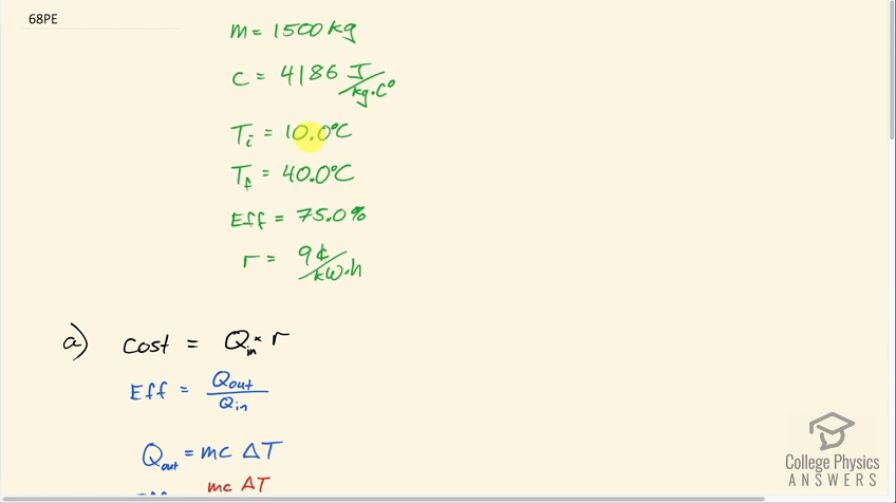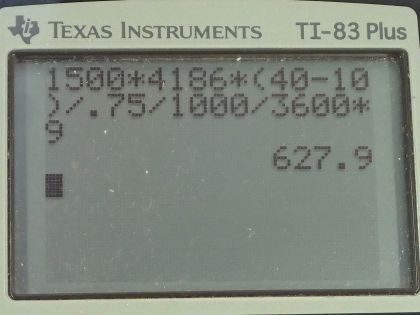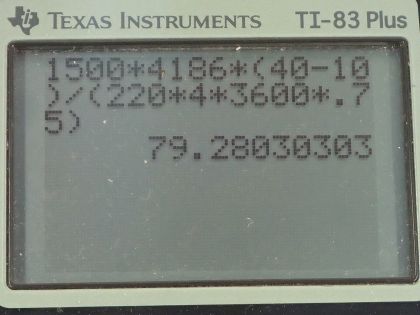Question
(a) What is the cost of heating a hot tub containing 1500 kg of water from to , assuming 75.0% efficiency to account for heat transfer to the surroundings? The cost of electricity is 9 cents/kW ⋅ h . (b) What current was used by the 220-V AC electric heater, if this took 4.00 h?
Final Answer
Solution video
OpenStax College Physics for AP® Courses, Chapter 20, Problem 68 (Problems & Exercises)

vote with a rating of
votes with an average rating of
.
Calculator Screenshots
Video Transcript
This is College Physics Answers with Shaun Dychko. What is the cost of heating a hot tub that has 1500 kilograms of water in it from a temperature of 10.0 degrees Celsius to 40.0 degrees Celsius assuming an efficiency of 75.0 percent of the heat is in the water of the hot tub and 25.0 percent of the heat is escaping to the surrounding air and ground around the hot tub. The cost for electricity is 9 cents for every kW·h and we found the specific heat of water— 4186 joules per kilogram per Celsius degree— and we found that in table [14.1] and so for water, we look it up here. Okay! So the cost is going to be the total energy input multiplied by the electricity rate and efficiency is the energy that goes into the hot tub water divided by the total energy supplied and the energy that goes into the hot tub water, the Q out in other words, is the mass of the hot tub water multiplied by its specific heat times its change in temperature. So we can replace Q out with mcΔT and then we solve for Q in by multiplying both sides by Q in divided by efficiency so Q in is mcΔT divided by efficiency so this can be replaced for Q in in this formula for the cost. So the cost then is the mass—1500 kilograms— multiplied by the specific heat of water times the change in temperature which is 40.0 degrees Celsius minus 10 and then divide that by 0.75 efficiency and that gives a total energy input to the system and then we have to do some unit conversion in order to multiply by our 9 cents per kilowatt-hour rate for electricity. So this is going to have units of joules because we have joules here and the kilograms canceled and you know, Celsius degrees canceled although Celsius degrees are not really a unit strictly speaking but we have joules and then we want to turn these joules into kilowatt-hours because we want to have kilowatt-hours in the numerator here to cancel with the kilowatt-hours here in the denominator of that rate. So we multiply the joules by 1 watt-second per joule because a watt-second is a joule, the joules cancel and we are left with watt-seconds, which is a strange unit but then we can turn it into kilowatt-seconds by multiplying by 1 kilowatt for every 1000 watts. So now we have kilowatt-seconds but what we really want are kilowatt-hours so we multiply by 1 hour for every 3600 seconds and now we have kilowatt-hours in our units here then multiply that by 9 cents for every kilowatt-hour and we get 627.9 cents, which is $6.28. And then in part (b), we are asked what current is used by a 220 volt AC electric heater if this took 4 hours to heat up the water? So we'll write down efficiency as the power output that goes into the water the rate at which heat enters the water divided by the rate at which heating energy is supplied to the heating system. And P in is going to be P out divided by efficiency when you multiply both sides by P in over efficiency and the P in is going to be current times voltage so we make that substitution here and then power output is the rate at which energy is supplied to raise the temperature of the water. So we replace the P out with mc change in temperature divided by time and then we are multiplying that by 1 over efficiency because this can be written as P out times 1 over efficiency and we just replace P out with all of this here. And then divide both sides by the voltage and we get then that the current is mcΔT divided by voltage times time times efficiency. So that's 1500 kilograms of water times the specific heat of water times the change in temperature divided by 220 volts times 4.00 hours converted into seconds by multiplying by 3600 seconds per hour times 0.75—efficiency— and that's 79.3 amps of current.

